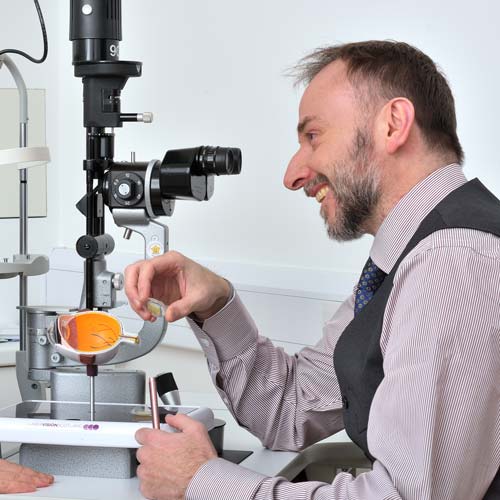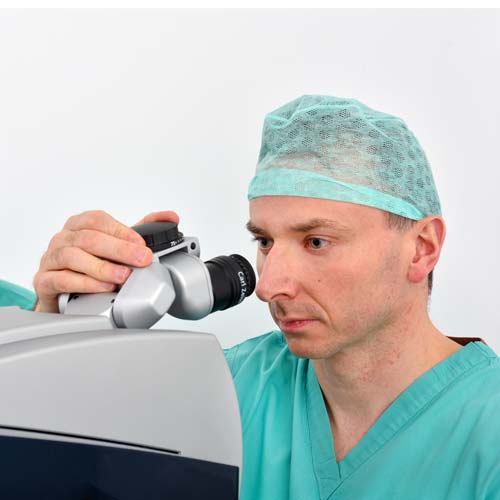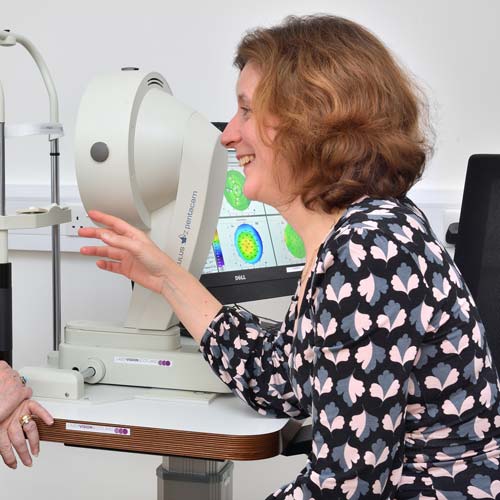What happens during Cataract surgery?
Cataract surgery
Cataract surgery is usually a quick, pain-free procedure. It can significantly improve your eyesight, with full recovery in two to six weeks.

Your treatment visit should take no longer than three hours. The cataract surgery itself takes less than 20 minutes.
On the day of surgery, you will arrive at your chosen facility’s reception and be directed to the Vision Scotland clinic. Here, we will put you at ease, most patients are slightly nervous and we will do our best to make you feel as calm as possible before surgery. Our nurses will go through some simple checks to ensure you are suitable for surgery and start applying drops where required. Most cataract surgery is performed under local anaesthetic and this is administered by instilling some drops in your eye. Initially, slightly irritable but only for a few seconds and then the eye is numb. Your Vision Scotland surgeon will come and meet with you before your cataract surgery and go through your consent form to make sure you are happy to go ahead and give you the opportunity to ask any questions you may have.
When the surgeon and theatre is prepared, you will be taken, normally by wheelchair, into the operating theatre. There will be a number of theatre staff there and of course, your Vision Scotland surgeon. You will be asked to lie, face up, on the operating table and made comfortable. The surgeon then will attach the drape over you.
This is a large specialised paper protection that isolates the eye to create a sterile environment for surgery. There will be a bright light and microscope above you to help the surgeon have the best view of your eye throughout the operation. You won’t be able to see the instruments used in the operation as your eye will be blurred from the drops and the bright light. You will have to lie relatively still for about 20 minutes for the duration of the surgery.


Many patients worry that they will blink during the operation, but this is avoided with a little clip to prevent the eyelids moving. During the surgery a small incision will be made at the top of the eye through which the instruments are placed. A narrow probe will break down the cataract and then seamlessly removed. The new intraocular lens which has been specially designed for your eye, will then be introduced into the eye. It is folded up and then gradually unfolds into place in the remaining lens capsule. Throughout this, your eye will remain numb and some patients report a sensation of ‘pushing and pulling’ but otherwise no discomfort will be felt.
At the end of the surgery, the surgeon will instill some more drops to guard against infection and reduce swelling and a clear eye shield will be placed over the eye area. You will then return to the lounge where the nurses will ensure you are well and you will be allowed to leave after approximately an hour.
Some patients are more nervous than others, understandably, so should you feel concerned please mention this to your surgeon who can either advise a gentle sedative via your GP or recommend general anaesthetic where appropriate. We always advise that if you can avoid a general anaesthetic this is preferable as more risks and costs are associated.
Drops are used to dilate the pupil of your eye.
Drops are used to dilate the pupil of your eye.
Lorem ipsum dolor sit amet, consectetur adipiscing elit. Ut elit tellus, luctus nec ullamcorper mattis, pulvinar dapibus leo.
Anaesthetic drops (no needles!) are then used to numb your eye so you won’t feel anything. You may feel pressure and a little discomfort.
Once the anaesthetic has taken effect, your surgeon will make a tiny cut on the surface of your eye. Thanks to the anaesthetic you won’t feel this.
Drops are used to dilate the pupil of your eye.
Anaesthetic drops (no needles!) are then used to numb your eye so you won’t feel anything. You may feel pressure and a little discomfort.
Once the anaesthetic has taken effect, your surgeon will make a tiny cut on the surface of your eye. Thanks to the anaesthetic you won’t feel this.
An ultrasound probe will gently break down and remove the cloudy lens.
Your new artificial lens is then carefully positioned into your eye.
Once your surgery is complete an antibiotic solution will protect you against infection – and then it's over. We'll take you to recover with some refreshments.
| Locations: | Aberdeen | Glasgow | Stirling |
|---|---|---|---|
| Surgery with Monofocal lens | £2750 | £3000 | £2500 |
| Locations: | Aberdeen | Glasgow | Stirling |
|---|---|---|---|
| Surgery with trifocal lens | £4235 | £3600 | £3650 |
| Locations: | Aberdeen | Glasgow | Stirling |
|---|---|---|---|
| Surgery with Monofocal lens (for astigmatism) | £3650 | £3195 | £3195 |
| Locations: | Aberdeen | Glasgow | Stirling |
|---|---|---|---|
| Surgery with Vivity lens | £4400 | £3900 | £3998 |